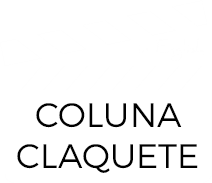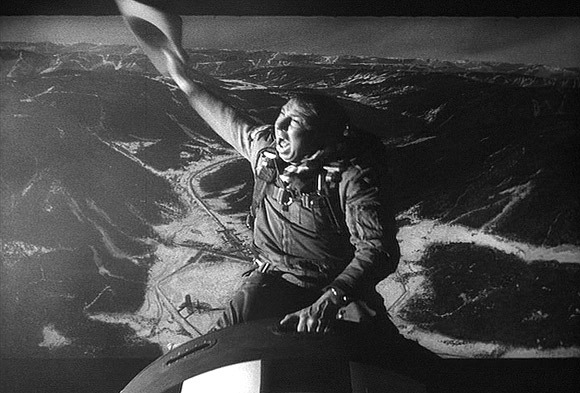Recommended movie: “Dr. Strangelove or: How I Learned to Stop Worrying and Love the Bomb”
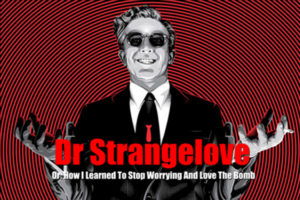 There are no limits to man’s thirst for power, and in the name of peace more and more wars explode. As it is easier to start one war than finishing it, there is always concern about where all this will lead. In a world more and more filled with Trumps and trump-copies, everything seems to be repeated continuously. A 1960s movie, which portrays this magnificently, is “Dr. Strangelove or: How I Learned to Stop Worrying and Love the Bomb” (USA, 1964), one of Stanley Kubrick’s masterpieces.
There are no limits to man’s thirst for power, and in the name of peace more and more wars explode. As it is easier to start one war than finishing it, there is always concern about where all this will lead. In a world more and more filled with Trumps and trump-copies, everything seems to be repeated continuously. A 1960s movie, which portrays this magnificently, is “Dr. Strangelove or: How I Learned to Stop Worrying and Love the Bomb” (USA, 1964), one of Stanley Kubrick’s masterpieces.
The film is a product of the Cold War era, made in 1963, in the midst of an arms race, where a children eater communist was seen under each bed. A man of unengaged vision, and a fierce critic of fanaticism, Kubrick was able to pass on to the screen the existing paranoia and the real risk to mankind. Unfortunately, the lessons do not seem to have served, as world leaders continue to repeat the same mistakes.
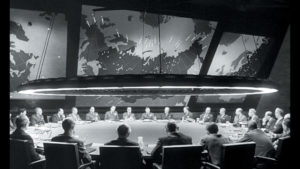 “Dr. Strangelove or: How I Learned to Stop Worrying and Love the Bomb” is based on a book entitled” Red Alert “, by Peter Bryant, which imagines the first two decisive hours of a nuclear war. In the same year, another film was based on this book, Sidney Lumet’s “Fail Safe”, with Henry Fonda and Walther Matthaus. But while Lumet showed the story in a dramatic view, Kubrick directed his film into the comedy. Both films are genius, do have not lost the current, and, for the pleasure of moviegoers, are available in various media.
“Dr. Strangelove or: How I Learned to Stop Worrying and Love the Bomb” is based on a book entitled” Red Alert “, by Peter Bryant, which imagines the first two decisive hours of a nuclear war. In the same year, another film was based on this book, Sidney Lumet’s “Fail Safe”, with Henry Fonda and Walther Matthaus. But while Lumet showed the story in a dramatic view, Kubrick directed his film into the comedy. Both films are genius, do have not lost the current, and, for the pleasure of moviegoers, are available in various media.
The two movies explore the same theme, the beginning of a nuclear war due to unforeseen factors. In “Dr. Strangelove or: How I Learned to Stop Worrying and Love the Bomb”, an deranged general who believed that the treatment of tap water was a process of communist domination, ordered a nuclear attack on Russia. Ironically, the motto of this airborne group was “Peace is our profession”.
To complicate matters, the Russians had developed the “doomsday weapon” that would be triggered automatically by a nuclear explosion, destroying life on Earth’s surface for ninety-three years.
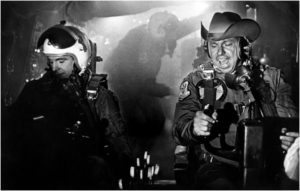 All American militaries are ruthlessly portrayed by Kubrick: Brigadier Ripper (Sterling Hayden), who orders the attack and faces his colleagues with a fifty-point machine gun, in the style that would become famous in “Rambo II” years later; the ultra-paranoid-radical General “Buck” Turgidson (George C. Scott, in anticipation of his most famous film “Patton”) who wants to take advantage of the incident and complete the war at all costs; Colonel “Bat” Guano (Keena Wynn), who after invading the barracks and killing several soldiers, does not want to damage a Coke machine because it is private property; Major TJ “King “Kong (Slim Pickens) the fanatic bomber pilot, who is the protagonist of the anthological “cavalcade” in the nuclear bomb.
All American militaries are ruthlessly portrayed by Kubrick: Brigadier Ripper (Sterling Hayden), who orders the attack and faces his colleagues with a fifty-point machine gun, in the style that would become famous in “Rambo II” years later; the ultra-paranoid-radical General “Buck” Turgidson (George C. Scott, in anticipation of his most famous film “Patton”) who wants to take advantage of the incident and complete the war at all costs; Colonel “Bat” Guano (Keena Wynn), who after invading the barracks and killing several soldiers, does not want to damage a Coke machine because it is private property; Major TJ “King “Kong (Slim Pickens) the fanatic bomber pilot, who is the protagonist of the anthological “cavalcade” in the nuclear bomb.
The cast is all inspired, starting with Peter Sellers, who plays three different characters: the English attache, Captain Mandrake, the only military with some sense in the film, the president of the United States, and the title role, the mysterious Dr. Strangelove. The latter, when it appears in the final part of the film, is a direct accusation of fascism to the militarists on call, calling the president of Mein Fueher, and making the Nazi salute, for example. Curiously, Sellers, who starred many comedies, including “Pink Panther,” plays the most contained roles in the movie.
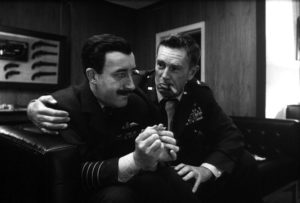 Of the leading actors in the film, the only one still alive is James Earl Jones in his movie debut. Jones became best known as the head of the CIA in the films “Hunt for Red October,” “Patriotic Games,” and “Real and Immediate Danger”. But few remember that he was the one who dubbed Darth Vader in the first Star Wars trilogy, and would return to the role in “Star Wars: Episode III – Revenge of the Sith” (2005) and “Rogue One: A Star Wars Story “(2016).
Of the leading actors in the film, the only one still alive is James Earl Jones in his movie debut. Jones became best known as the head of the CIA in the films “Hunt for Red October,” “Patriotic Games,” and “Real and Immediate Danger”. But few remember that he was the one who dubbed Darth Vader in the first Star Wars trilogy, and would return to the role in “Star Wars: Episode III – Revenge of the Sith” (2005) and “Rogue One: A Star Wars Story “(2016).
As this is a movie that interests the collectors, there have been excellent editions in DVD and Blu-Ray. A curious thing is the screen format, Full Screen (1.66: 1), which corresponds to the 16mm of the cinema, so that there is no loss of image. Legend says that Kubrick loved and prefered that format. The audio brings the original mono sound and also in 5.1 TrueHD and the movie is black and white. All of this may seems disadvantageous in comparison to current films but is part of a harmonic set of Kubrick’s work.
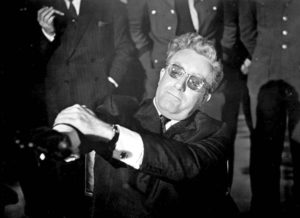 It is as if we were watching the original work, without the little scratches on the screen. The image, by the way, is exquisite. The special effects are poor, but convincing, for that age. Speaking about special effects, Kubrick would enchant the world, a few years later, with “2001, a Space Odyssey”.
It is as if we were watching the original work, without the little scratches on the screen. The image, by the way, is exquisite. The special effects are poor, but convincing, for that age. Speaking about special effects, Kubrick would enchant the world, a few years later, with “2001, a Space Odyssey”.
Blu-Ray features the same extras as the American edition, including a documentary about Kubrick’s life and work, a Dr Strangelove’s Making Of, documentaries about Cold War and Peter Sellers, and even an interview with Robert McNamara. Secretary of Defense of the United States from 1961 to 1968. Although the film has subtitles in Portuguese, the extras only have them in English and Spanish.
 “Dr. Strangelove or: How I Learned to Stop Worrying and Love the Bomb” is a film that is worth watching, and discussed with friends, children, neighbors, dogs and parrots. It is important to note that those who have the power to push important buttons often take their decisions based on the most personal and absurd motives, without worrying about the consequences for millions of citizens. And, to make the program more interesting, how about a triple session with “Fail-Safe” and “The Sum of All Fears”?
“Dr. Strangelove or: How I Learned to Stop Worrying and Love the Bomb” is a film that is worth watching, and discussed with friends, children, neighbors, dogs and parrots. It is important to note that those who have the power to push important buttons often take their decisions based on the most personal and absurd motives, without worrying about the consequences for millions of citizens. And, to make the program more interesting, how about a triple session with “Fail-Safe” and “The Sum of All Fears”?
Original Title: “Dr. Strangelove or: How I Learned to Stop Worrying and Love the Bomb ”
